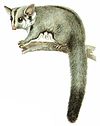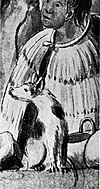Biota of New Ingrea/Mammals
Mammals are the rarest of the various classes of animal that make up the biodiversity of the Moonshine Archipelago. However, the islands are considered special for mammalogists in that they contain native species from the three major infraclasses of mammal - monotremes, maursupials, and placentals. Fossil evidence also suggests that the islands once also played host to extinct lineages of mammal, such as Allotheria.
All of native mammals to be found on islands are thought to be descended from ancestors who rafted to islands after they emerged from the sea about 40 million years ago.
Since the XIII century, a number of mammals have been introduced either accidentally or deliberately by human settlers, leading to significant pressure on native species across all categories, and leading to the extinction of some, with birds particularly affected.
Key
Denotes introduced species.
Monotremes
Order: Monotremata
| Species | Distribution | Conservation status |
Notes | |
|---|---|---|---|---|

|
Kaihōnuhinu (Tachyglossus aculeatus) | Lunen Island, Brunswich Island | ||

|
Tāwhirimaru (Ornithorhynchus anatinus) | Brunswich Island | ||
Marsupials
Order: Diprotodontia
| Species | Distribution | Conservation status |
Notes | |
|---|---|---|---|---|

|
Pīkauhuruhuru (Acrobates pygmaeus) | Lowland forest north of 52°30'S | ||

|
Rūrūpepeke (Cercartetus broomii) | Mount Alexander National Park, Brunswich Island | ||

|
Tōpīwai (Cercartetus parvus) | Lunen Island, Brunswich Island | ||

|
Kōkōrere (Petaurus breviceps) | Lunen Island, Brunswich Island | ||







